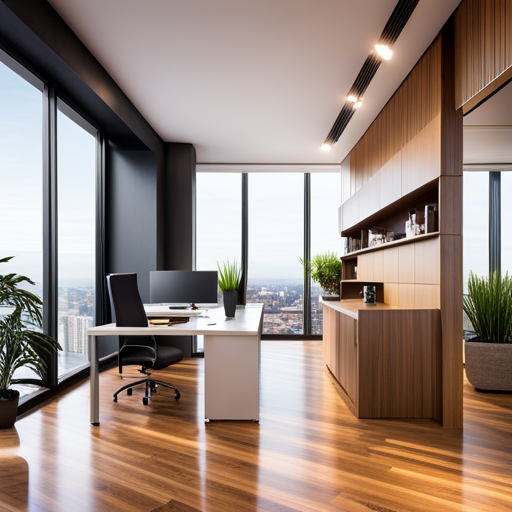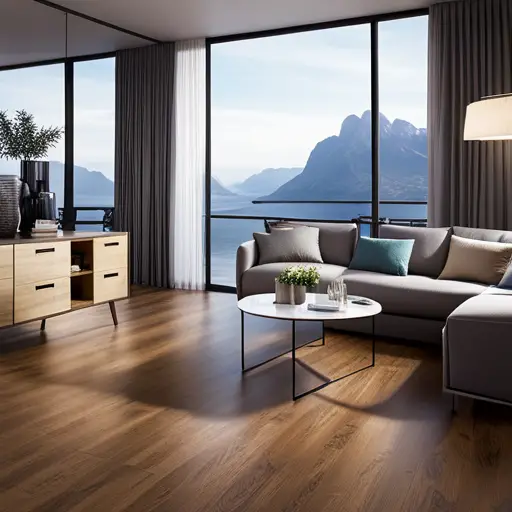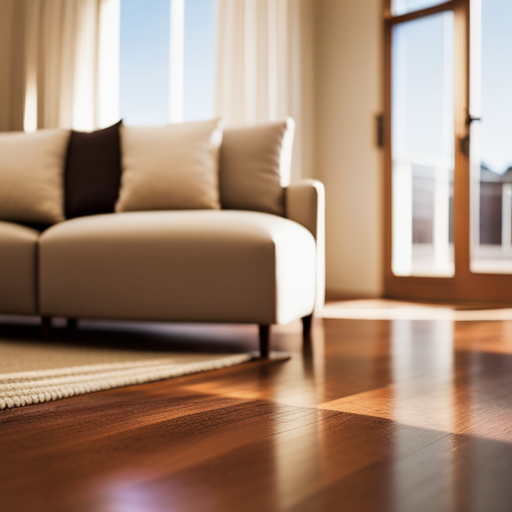How Flooring Can Enhance Workspace Environments

Step into a workspace where every step is a testament to productivity, comfort, and safety.
The right flooring has the power to transform a work environment, reflecting brand identity, improving acoustic environment, and promoting wellness.
From boosting morale to creating a visually appealing space, the impact of flooring on workspace environments cannot be overstated.
In this article, we explore the myriad ways in which flooring can enhance the functionality and aesthetics of workspaces.
Boosting Productivity
To boost productivity in the workplace, selecting the right flooring can play a crucial role in creating a conducive environment for efficient work. The choice of flooring material can significantly impact the overall atmosphere of a workspace, influencing employee motivation, comfort, and even health. By investing in high-quality, ergonomic flooring solutions, businesses can enhance their employees’ working conditions, leading to increased efficiency and optimized workflow.
Studies have shown that the physical work environment directly affects employee productivity. An uncomfortable or unsuitable floor can cause discomfort, leading to distractions and decreased output. On the other hand, well-chosen flooring materials, such as anti-fatigue mats or carpeting, can contribute to a more pleasant and secure workspace, thereby promoting a more focused and productive workforce.
In addition to comfort, the right flooring can also contribute to a safer workplace, reducing the risk of slips, trips, and falls. This not only enhances employee well-being but also ensures that time and resources are not diverted to deal with preventable accidents, further increasing overall efficiency.
Enhancing Comfort and Safety
Enhancing comfort and safety in the workspace is crucial for promoting employee well-being and productivity.
One way to achieve this is by improving ergonomic support through the use of flooring materials that offer cushioning and support for long hours of standing or walking.
Additionally, reducing slip and trip hazards through the implementation of non-slip flooring solutions can significantly contribute to a safer work environment.
Improving Ergonomic Support
One of the key considerations for enhancing comfort and safety in the workspace environment is by providing flooring that supports and promotes ergonomic well-being.
Ergonomic design plays a crucial role in creating a workspace that prioritizes the well-being of employees. By integrating ergonomic principles into flooring choices, businesses can significantly improve workplace efficiency.
Ergonomically designed flooring can reduce the risk of slips, trips, and falls, thereby enhancing safety. It also contributes to the overall comfort of employees, leading to increased productivity and job satisfaction.
Additionally, ergonomic flooring solutions can help in minimizing physical strain and fatigue, allowing employees to work more comfortably for longer periods.
Ultimately, investing in ergonomic flooring not only promotes a safe and comfortable work environment but also positively impacts the overall efficiency of the workplace.
Reducing Slip and Trip Hazards
The reduction of slip and trip hazards in the workspace environment is a crucial consideration for promoting the safety and comfort of employees. Implementing safety measures to enhance slip resistance and prevent falls is essential for reducing workplace accidents. Choosing flooring materials with high slip resistance and incorporating fall prevention strategies can significantly contribute to a safe and comfortable workspace. Here is a table outlining some key factors to consider when reducing slip and trip hazards in the workplace:
| Factors to Consider | Description | Importance |
|---|---|---|
| Flooring material | Choose materials with high slip resistance | High |
| Adequate lighting | Ensure proper visibility to identify potential hazards | Medium |
| Regular maintenance | Keep flooring surfaces in good condition to prevent trip hazards | High |
| Clear walkways | Maintain clutter-free and well-organized pathways | High |
| Anti-slip treatments | Apply anti-slip coatings or treatments to flooring surfaces | Medium |
These measures collectively contribute to a safer and more comfortable workspace, reducing the risk of slip and trip hazards.
Reflecting Brand Identity
Effective brand identity reflection through flooring design requires careful consideration of color, texture, and material to align with the company’s values and image. The flooring within a workspace plays a significant role in brand recognition and corporate image.
For instance, a vibrant and dynamic company may opt for colorful and patterned carpets to reflect its energetic corporate culture, whereas a more traditional and professional organization may choose sleek and sophisticated hardwood floors to convey a sense of timeless elegance. The use of company colors and logos within the flooring design can further reinforce brand recognition and create a cohesive visual identity throughout the workspace.
By integrating brand elements into the flooring, such as incorporating the company logo as a focal point or using colors that are synonymous with the brand, employees and visitors are subconsciously reminded of the company’s values and mission. This not only creates a visually appealing workspace but also fosters a strong connection between the physical environment and the company’s identity.
As we delve into the impact of flooring on workspace environments, it’s essential to consider how flooring can also contribute to improving the acoustic environment.
Improving Acoustic Environment
When considering workspace design, the acoustic environment plays a crucial role in overall productivity and comfort.
Selecting sound-absorbing flooring materials can significantly reduce noise levels and create a more peaceful atmosphere.
Additionally, the use of such materials can enhance speech intelligibility, contributing to clearer communication and a more effective work environment.
Sound-Absorbing Flooring Materials
One effective way to improve the acoustic environment in workspaces is through the use of sound-absorbing flooring materials. These materials not only enhance the overall aesthetic appeal of the workspace but also contribute to a more productive and comfortable environment. Sound-absorbing flooring offers design flexibility, allowing for a wide range of customizable options to suit different interior styles. In addition to enhancing the visual appeal, these materials provide environmental sustainability benefits and are known for their material durability, making them a long-term investment for any workspace. The table below highlights the key features of sound-absorbing flooring materials, emphasizing their role in creating a balanced and pleasant acoustic environment.
| Key Feature | Benefits | Examples |
|---|---|---|
| Design Flexibility | Customizable options to suit interior styles | Modular Carpet Tiles, |
| Aesthetic Appeal | Enhances overall visual appeal | Cork Flooring, |
| Environmental Sustainability | Eco-friendly materials | Recycled Rubber Flooring, |
| Material Durability | Long-term investment | Vinyl Plank Flooring |
Noise Reduction Benefits
To enhance the acoustic environment in workspaces, noise reduction benefits can be achieved through the selection of appropriate flooring materials. Soundproofing solutions such as carpets, cork, rubber, and vinyl can significantly contribute to creating a quieter workplace ambiance. These materials absorb and dampen sound, thereby reducing noise levels and minimizing distractions.
By integrating sound-absorbing flooring into the acoustic design of a workspace, the overall ambiance can be improved, leading to enhanced productivity and focus among employees. The strategic placement of these flooring materials in high-traffic areas can effectively minimize the transmission of sound, creating a more peaceful and conducive working environment.
Ultimately, prioritizing noise reduction through flooring choices is a valuable investment in cultivating a productive and harmonious workspace.
Enhancing Speech Intelligibility
Improving speech intelligibility through the strategic placement of sound-absorbing flooring materials contributes to a more productive and harmonious acoustic environment in workspaces. This enhancement directly impacts workplace efficiency by improving communication and reducing distractions.
The following considerations can help achieve optimal speech intelligibility:
-
Material Selection
-
Choosing sound-absorbing flooring materials such as carpet, cork, or rubber can significantly reduce noise reverberation, enhancing speech clarity.
-
Strategic Placement
-
Placing sound-absorbing flooring materials in high-traffic areas, meeting rooms, and open workspace layouts can minimize sound reflections and improve communication effectiveness.
Facilitating Easy Maintenance
Facilitating easy maintenance of the workspace flooring is essential for ensuring a clean and professional environment. Choosing flooring materials that prevent stains and increase durability is crucial in minimizing the time and effort required for upkeep. Stains can detract from the overall appearance of the workspace and may be challenging to remove, especially on surfaces that are not stain-resistant. By selecting flooring options that are resistant to staining, such as sealed hardwood or stain-resistant carpet tiles, maintenance becomes more manageable, and the flooring maintains its aesthetic appeal over time.
In addition to preventing stains, prioritizing durability in flooring materials is paramount. High-traffic areas in workspaces require durable flooring to withstand the constant wear and tear. Durable flooring materials not only reduce the frequency of replacements and repairs but also contribute to a more cost-effective maintenance strategy. This is particularly important in commercial settings where minimizing downtime for maintenance is crucial for business operations. By investing in durable flooring that is easy to maintain, businesses can uphold a clean and professional environment with minimal disruption.
Promoting Wellness and Health
Prioritizing the use of flooring materials that contribute to air quality and ergonomic comfort is essential for promoting wellness and health in the workspace environment. By incorporating flooring solutions that support the overall well-being of employees, businesses can enhance productivity and create a positive work environment.
-
Enhanced Air Quality
-
Selecting flooring materials that are low in volatile organic compounds (VOCs) can contribute to improved indoor air quality, reducing the risk of respiratory issues and allergies among employees.
-
Investing in flooring options that are easy to clean and maintain can help prevent the accumulation of dust, allergens, and other pollutants, further supporting a healthier indoor environment.
-
Supportive Ergonomic Comfort
-
Pairing flooring choices with ergonomic furniture can create a workspace that minimizes physical strain and discomfort, promoting better posture and reducing the risk of musculoskeletal issues.
-
Incorporating flooring solutions with shock-absorbing properties can alleviate pressure on employees’ joints, enhancing overall comfort and reducing the likelihood of workplace injuries.
Creating Visual Appeal
To complement the emphasis on wellness and health, the visual appeal of flooring in workspace environments plays a crucial role in creating a professional and inviting atmosphere for employees and visitors alike. Color psychology and texture variety are essential elements in creating a visually appealing workspace. Color psychology suggests that different colors can evoke specific emotions and moods. For example, blue is often associated with calmness and productivity, while green can promote a sense of balance and harmony. By incorporating these color principles into the flooring design, a workspace can be tailored to enhance the desired atmosphere. Texture variety in flooring, such as carpeting, hardwood, or vinyl, can add depth and dimension to the space, creating visual interest and a tactile experience for occupants. A well-designed combination of colors and textures can also help in wayfinding within the workspace, leading to improved navigation and a more organized environment. The table below illustrates how different flooring options can be used to create a visually appealing workspace environment.
| Flooring Type | Color Options | Texture Options |
|---|---|---|
| Carpeting | Neutral, earth tones | Plush, cut pile |
| Hardwood | Light, dark stains | Smooth, distressed |
| Vinyl | Various patterns | Wood, stone textures |
Frequently Asked Questions
How Can Flooring Choices Impact the Overall Mood and Atmosphere of a Workspace?
Flooring choices greatly influence workspace ambiance. Color and texture impact mood and productivity. Durable materials enhance longevity and reduce maintenance costs. Careful selection can create an inviting, comfortable, and productive work environment.
What Are Some Innovative Flooring Options That Can Promote a Sense of Creativity and Innovation in a Workspace?
Innovative designs and creative materials in flooring can foster a sense of creativity and innovation in a workspace. These options can inspire and invigorate employees, leading to a more dynamic and productive work environment.
Are There Any Flooring Materials That Can Contribute to Improved Air Quality in a Workspace?
Improving air quality in the work environment is crucial for employee well-being. Certain flooring materials, such as low VOC carpets and natural hardwood, can contribute to air quality enhancements, creating a healthier and more productive workspace.
How Can Flooring Design and Layout Affect the Flow and Functionality of a Workspace?
A well-designed flooring layout can significantly impact the flow and productivity of a workspace. By strategically placing different flooring materials and patterns, it can enhance collaboration and create distinct zones for different work activities.
What Are Some Sustainable and Eco-Friendly Flooring Options That Can Contribute to a More Environmentally Conscious Workspace?
Sustainable materials and eco-friendly designs are crucial for creating an environmentally conscious workspace. Options like bamboo, cork, reclaimed wood, and recycled carpet tiles offer durability and aesthetic appeal, while minimizing environmental impact.
Conclusion
In conclusion, it is ironic that something as seemingly mundane as flooring can have such a profound impact on the overall workspace environment.
From boosting productivity to promoting wellness, the choice of flooring plays a crucial role in creating a comfortable, safe, and aesthetically pleasing workplace.
It is important for businesses to consider the impact of flooring on their employees and overall brand identity, as it can truly enhance the workspace environment in unexpected ways.

Rubin Everest, a seasoned expert in the world of flooring, brings a wealth of knowledge and passion to the surface. As the mind behind ebbow.com, Rubin is dedicated to sharing insights on the latest trends, innovative solutions, and expert advice in the realm of flooring. Whether you’re seeking practical tips for installation or design inspiration, Rubin Everest is your go-to source for all things flooring-related, making your journey to the perfect floor an informed and enjoyable experience.





